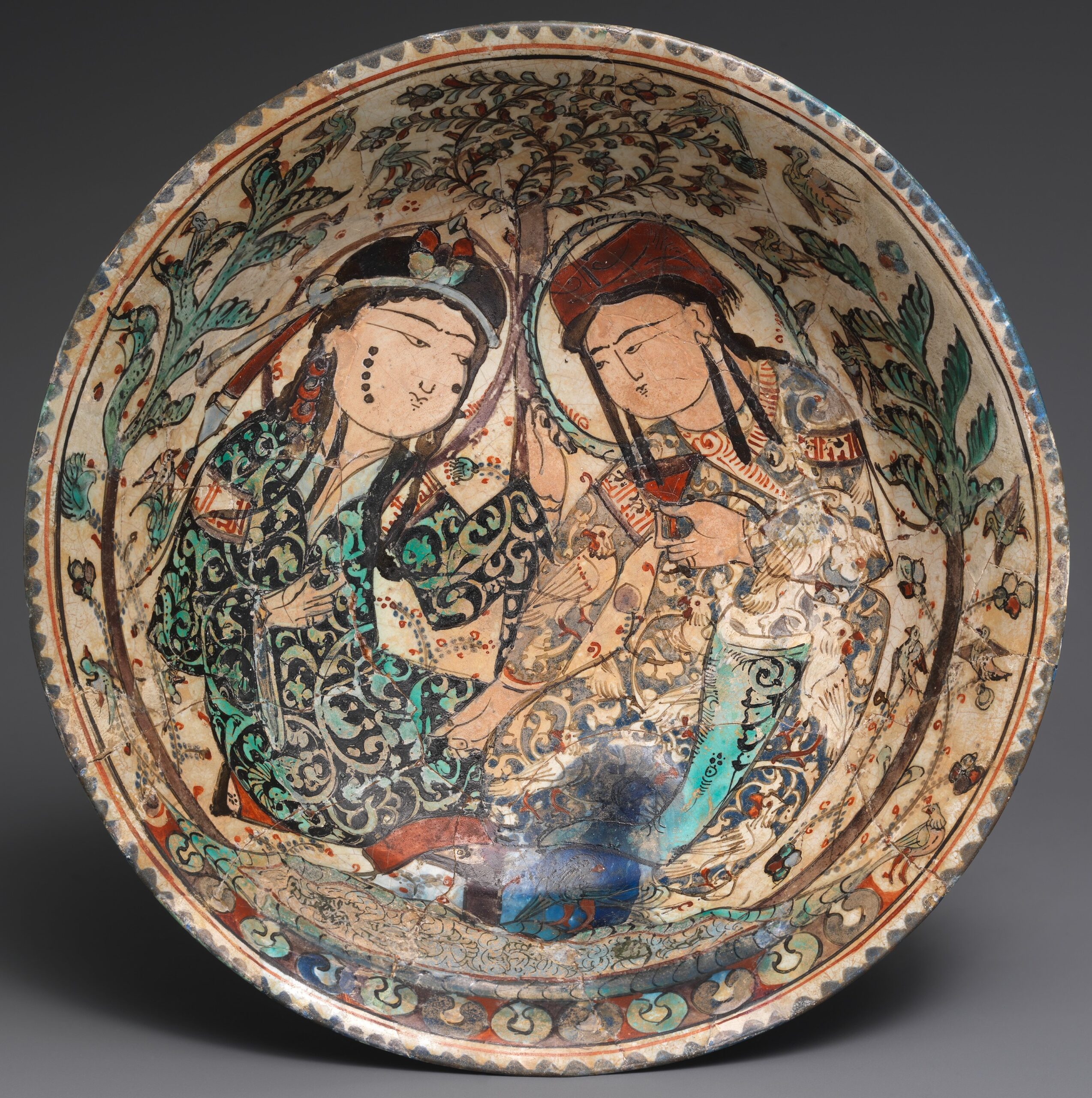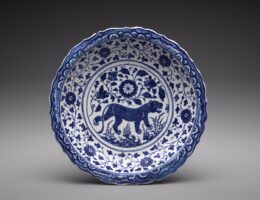IRAN ART EXHIBITION: PERSIAN POTTERY IN ANCIENT TIMES IN IRAN
Some 3,000 years ago, in the area south of the Caspian Sea in what is now modern Iran, craftsmen developed a distinctive type of pottery. This small installation features some of the outstanding treasures in the Sackler Gallery’s collection of ancient Iranian ceramics. It celebrates the talents of ancient Iranian potters, and showcases the high quality of their crafted works.
The History of Persian Ceramics
Pottery making in the Iranian Plateau dates back to the Early Neolithic Age (7th millennium BCE) with the production of coarse, unglazed wares. Later wares were made from earthenware clays with a layer of white slip (engobe). They were covered by transparent lead glazes and colors were added with oxides. Persian ceramics matured with time into more elaborate styles and techniques.
During the 7th century, the Arabs conquered Persian territory as well as Syria, Palestine and Mesopotamia. A large part of North Africa was conquered next, including Egypt.
In 717 CE, occupation of the Iberian peninsula took place, making the Arab empire one of the strongest .This set the stage for a development in Persian art forms based on Roman, Greek, Egyptian, and Central Asiatic ideas. The blending of these ideas from many regions was seen in the products of the ceramic industry. Influenced by techniques already practiced in conquered territories, Persian potters developed new forms and styles to produce the fine wares that characterize Persian ceramics. Because refined wares were mostly destined to serve and decorate the homes of the wealthy, or for export, this industry received great patronage and support.
During the 9th century under the Abbasid rulership, additional styles and techniques were adopted and refined, later evolving into even more elaborate and exquisite forms. The use of cobalt blue dates to this period, as does the use of other metallic oxides, such as copper, to produce blues and greens. Potters at this time were also experimenting with slip decorations, and were able to control the liquid slip to create elaborate and intricate decorations. Colors such as manganese purple, tomato red, olive green, yellow and brown were applied to the surface and then covered with a transparent glaze, creating a glossy and smooth finish.
The 11th century brought dramatic changes to the ceramic industry, influenced by Chinese porcelain ware. For a time Persian potters had tried to imitate the Chinese potter’s porcelain ware, but they were unsuccessful because they lacked kaolin, a fine clay used for the production of porcelain. With the introduction of the Frit Ware, however, Persian potters were able to produce the smooth surface they sought. This new clay body was composed of white clay, powdered glass and quartz. Its soft consistency facilitated the use of new techniques such as engraving, piercing and molding.
IRAN ART EXHIBITION: By the 12th century, Persian ceramic styles were well established and they set the standards for further innovations and conventions. In the 13th century, however, ceramics took an abrupt turn with the Mongol conquest, and for a time, pottery production halted. Wares made during the Mongol occupation are called Il Kanid wares, referring to the ruling dynasty. In the 14th century the arts revived again, with the invasion of the Timur, under whose rule new centers of pottery production appeared. Kirman became one of the main centers.
The control of the Iberian peninsula and the fall of Granada in 1492, added polychrome pottery to the colorful spectrum of Persian ceramic styles.
Through the centuries, Persian potters have responded to the demands and changes brought by political turmoil by adopting and refining newly introduced forms and blending them into their own culture. This innovative attitude has survived through time and influenced many other cultures around the world.

A new look at ancient Iranian ceramic
A New Look at Ancient Iranian Ceramics, from the Arthur M. Sackler Foundation, is the first major exhibition of ancient Iranian ceramics in over a decade. The exhibition features forty-five extraordinary pieces that illustrate the 5,000-year ceramic tradition that flourished in ancient, pre-Islamic, Iran until 100 BC.
The beautiful, technically sophisticated, and often-amusing ceramics of ancient Iran demonstrate a rich yet little known tradition comparable to pre-Columbian, Chinese and Greek achievements, establishing ancient Iranian pottery as one of the great ceramic traditions.
The jugs, jars, beakers and spouted and shaped vessels in the exhibition were used for holding, pouring and drinking liquids, especially wine. Wit and Wine explores how ancient Iranian potters made and decorated these vessels with high quality of craftsmanship and design, and often with a unique sense of humor. Many pieces are shaped like animals or are painted with animal motifs. Interpretations of wild and domesticated animals show elegant deer, powerful rams and amusing goats. Some pieces were created to serve specific functions, such as cosmetic containers, some vessels were made to look like metal, and others are purely sculptural forms.
Included in the exhibition are an extraordinary ceramic head and neck of a bull, a vessel in the form of a seated camel, a stag head rhyton (drinking horn), a vessel with a deer’s head spout, a vessel in the form of a stag, a spouted vessel in the shape of a bull, and a delightful vessel with two feet.
Iran Ceramics & Pottery
Ceramic Industry is one of the oldest industries in the world. The first ever-excavated ceramic objects belonging to 10 to 12 thousand years ago were explored in Zagros mountain range in Iran that indicate a long and shining history in it. Archeological studies in Iran have shown that pottery in Iran has a history as old as 8,000 years.
IRAN ART EXHIBITION: One of the most important characteristics of the pottery and ceramics in different regions of Iran is “the expressive and beautiful decorations” on them. These decorations in different parts of Iran are completely compatible with the people’s belief, culture and climate of those areas.
Exceptional and marvelous items were created in that era. Decorating historical monuments and buildings inclusive of mosques in Isfahan and other Iranian towns. The color and quality of Iranian tiles and ceramics are so unique that they have resisted hard climatic and erosive conditions of Iran for centuries. “Sultanabad” and “Lajvardina” are two types of pottery.






